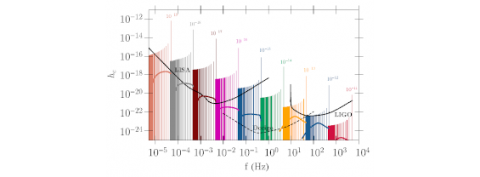Shedding light on ultralight dark matter with gravitational-wave beacons

English
Thursday, 28 May, 2020
Some models of dark matter suggest the existence of ultralight particles, with masses much smaller than 1e-10 eV. Because of their tiny mass and fleeble interactions, detecting these elusive particles is impossible on Earth. However, if such ultralight particles exist in the Universe, they would extract energy and angular momentum from black holes, turning them into "gravitational-wave beacons" that emit a peculiar periodic signal. This effect is called "black hole superradiance" and provides a portal to look for otherwise invisible ultralight dark matter with current and future gravitational-wave interferometers.
So far, black hole superradiance and its gravitational-wave signatures have been studied for the simple case of scalar (i.e., spin-0) particles (with properties similar to the Higgs boson) and for vector (i.e., spin-1) particles (with properties similar to the photon). In a new paper published in the journal Physical Review Letters, a team of researchers from the Physics Department at Sapienza University of Rome and from Milano Bicocca University showed that black hole superradiance occurs also for tensor (i.e., spin-2) particles, those with properties similar to the graviton. If such particles exist and have a tiny mass, almost any black hole in the universe could potentially emit gravitational waves periodically at a given frequency (which is directly related to the particle mass). By searching for this signal, detectors such as LIGO and Virgo (and the future space mission LISA supported by ESA and NASA) will hunt for ultralight dark matter in a new, almost unexplored, regime.
This study is part of the Marie Skłodowska Curie project "FunGraW" and of the ERC project DarkGRA hosted at the Physics Department.
Reference:
Richard Brito, Sara Grillo, and Paolo Pani, "Black Hole Superradiant Instability from Ultralight Spin-2 Fields"
